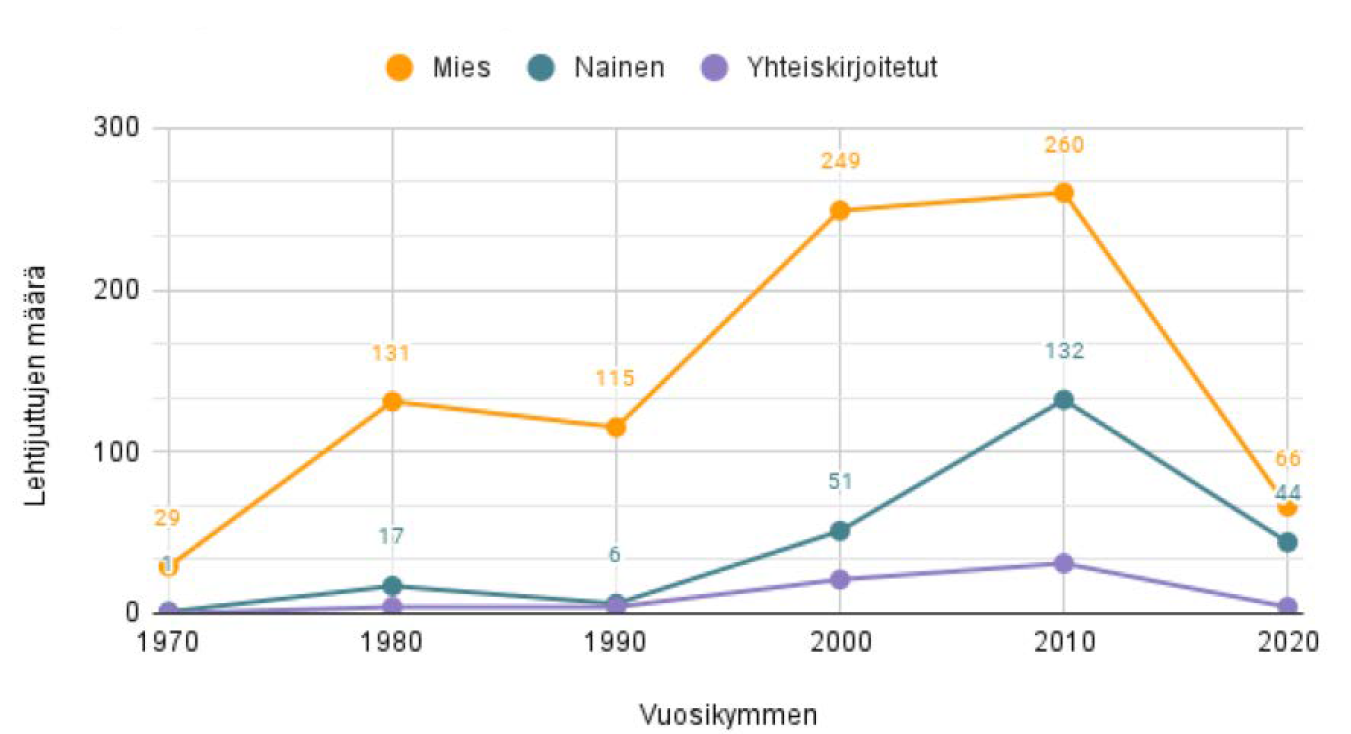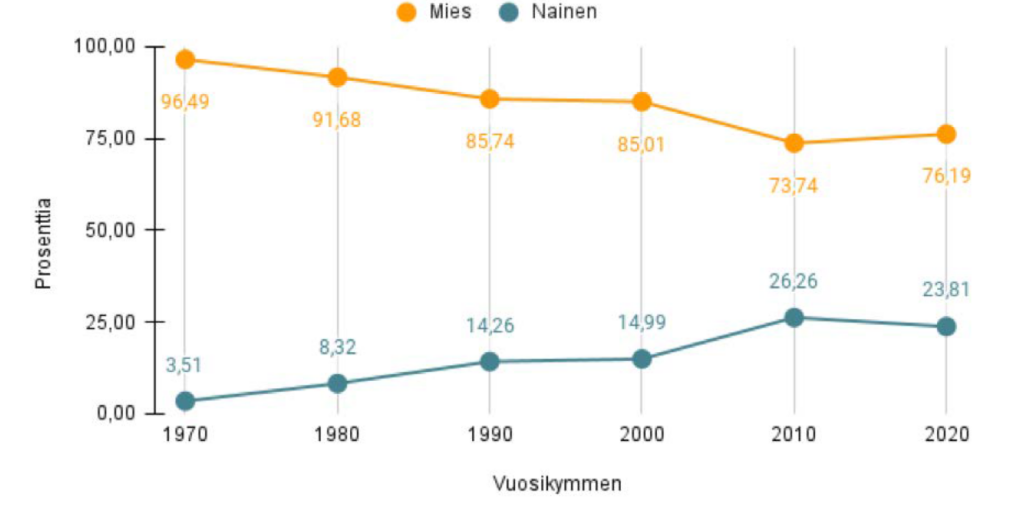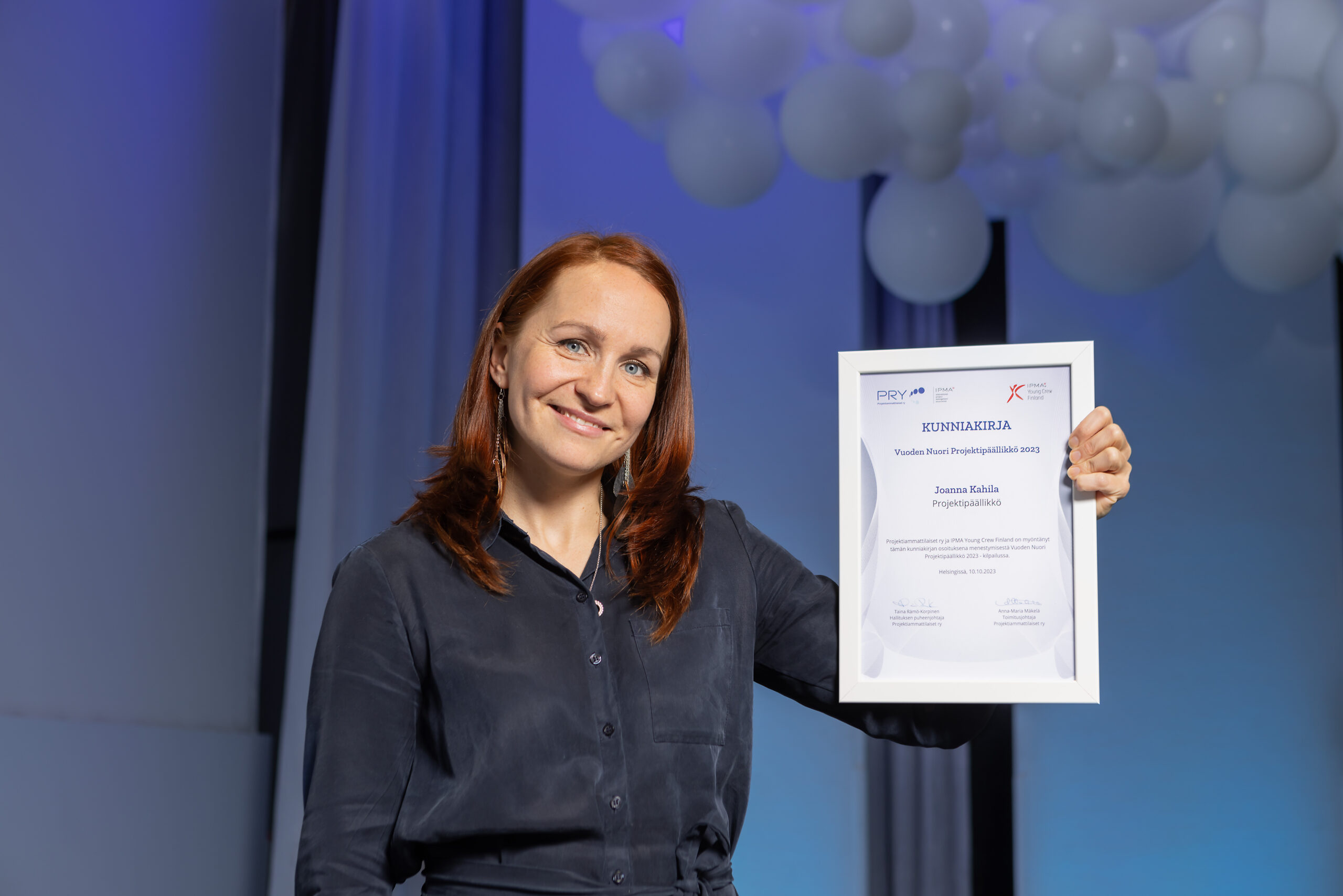Finland is the promised land of equality, but we still have many areas where there is very strong gender segregation. What does the project sector look like from a gender perspective and how has the situation changed over the last 45 years? In my thesis, I try to explore the current state of gender equality and its development by using PRY publications from different decades.
Text by Tiina Toivola
Photos Tiina Toivola

Graph 1. Number of articles by gender (Orange=Male, Green=woman, Purple=both)
When I was studying project management, I paid attention to the gender balance of my student group. Almost 70% of our group was female, but still my image of project managers and the field in general was heavily male-dominated. My studies allowed me to immerse myself in the project sector, its actors and publications, and this reinforced my image of a male-dominated field. I wanted to find out whether the project industry was indeed male-dominated.
There was very little information on the subject, so I decided to research the topic in my thesis. In addition to the current situation, I also wanted to find out how gender equality in the project sector has developed over the years. The material found its way to me on its own when I received the Projektimaailma magazine in my mailbox. I knew that a printed publication would provide good historical material for research. The size of the material is large, as the magazine and its previous editions have been published since 1978. The aim of the thesis was to investigate the state of gender equality in the project sector and its development from the 1970s to the 2020s.
Implementation of the survey
In my research, I used both qualitative and quantitative research to draw statistical generalisations from the data, but also to describe the manifestations of gender equality. The analysis of the data has been carried out using content analysis. The thesis is based on the knowledge base of gender, media and labour studies. In particular, the study aimed to pay attention to the images of gender, the language associated with gender and differences in the quantitative incidence of gender.
The project sector is seen as male-dominated, according to the publication
As a result of the survey, it can be concluded that the project sector is still perceived as male-dominated, although there have been developments towards more equality, especially in the 2000s. In the early years of the magazine, there were hardly any women in the publication, and even in the 1970s there was a weak signal that women were not wanted in a very male-dominated project sector. In the 1980s, more traditional gender roles and a very strong male normality were emphasised. Words and phrases referring to men were commonly used to describe workers in the sector. In the 1990s, the journal strongly reflected the growth of public-side projects and the rise of soft management skills. This also explains the increase in the number of women in the magazine’s content.
In the 21st century, equality is really coming into its own, and it is reflected in the composition of government and in the values debate in the press, for example. However, gendered terms are strongly male-gendered. Projects are very often manned, decisions are made by one man, and project managers are kings. In 2014, for the first time, the majority of the magazine’s writers were women, a watershed moment, as women in general had accounted for less than 30% of the magazine’s writers in the 2010s. In the 2020s, gendered terms declined and the term “supervisor” started to become more common, rather than “manager”.

In the 2020s, male writers will outnumber female writers in the magazine. Women will write around 37% of newspaper articles and men 55% (Figure 1). However, on average, women write longer articles than men. Interestingly, although the number of women writers has increased, there are still more men than women quoted in newspaper articles (Graph 2). Of those mentioned by male writers, 88% were men and 12% were women. In contrast, 70% of the people mentioned by women were men and 30% were women.
What do these findings tell us about the project sector?
From the reader’s point of view, the project sector still seems to be male-dominated, although there has been progress towards greater equality. It is indeed possible that the project sector is still male-dominated and the publication is just a reflection of reality. So if the project industry is more likely to be male, it is just as likely to be male-dominated in the industry’s trade magazine. In particular, the male dominance of the early decades of the publication can be explained purely by the fact that the project-based way of working was concentrated in male-dominated sectors. The image of the project industry as a male-dominated field is left to the reader and may influence women’s perceptions of the field and identification with the project industry. However, the future looks bright and the project sector is moving strongly towards gender equality.
The PRY has always had an eye on the future
As a reader, I was able to fast-forward from the 1970s to the present day. A lot happened between each issue, and although some of the ideas and thoughts never saw the light of day, the Association’s ideas and activities have been strongly promoted. The PRY has lived through its glory days and, on the other hand, has also struggled at times with the fading of its activities. The PRY has provided us all with common ground in areas such as theory and standardisation. It has always had an eye on the future and has been open-minded about the opportunities that the future holds. For example, artificial intelligence and its potential, which is much discussed today, was already mentioned in the magazine in the 1980s.
Author
Toivola is an expert in the CreaDive project and trains future community educators. This article is based on her thesis for her Master’s degree in Project Management.



